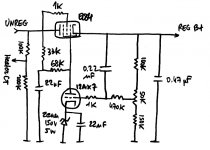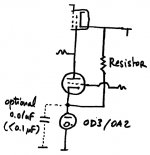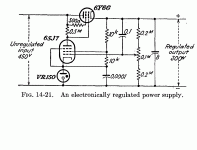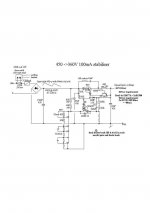Hello,
Wanting to have a less noisy phono preamp, I am getting into PSU voltage regulation (currently about 350VDC B+). From the different sources I found on the internet, I will do this (see schematic) inspired from an Audio Note M2 Kit schematic, changing the 6BM8 to EL84+paralleled12AX7 (in stock at home). It uses a bypassed 150V zener reference to the cathode of the error 12AX7 tube.
When you want to use a cool looking
cool looking  gas reg instead of zener (say 0D3 (on order since today
gas reg instead of zener (say 0D3 (on order since today  or 0A2 tube), I often see an added resistor (gas tube plate to regulated output) to the former schematic : see schematic no2,all other components remaining the same
or 0A2 tube), I often see an added resistor (gas tube plate to regulated output) to the former schematic : see schematic no2,all other components remaining the same
By thye way, most schematics show separate resistors joining at the G2 of a pentode error tube instead of triode.
Is it intended the same as a typical gas reg shunt regulator (current limiting series resistor)?
B+ UNREG will come from a slow start rectifier (5Z4, GZ34...) then CRC (I DON'T like choke sound so far), the necessary elevation of reg tubes heater filaments being fed just after that (as Audio Note does... less noise than if on B+REG side?). The preamp will draw about 12-16mA : RCA inspired CR passive RIAA EQ two stages high gain 12AX7 + lower output impedance 12AY7 or 12AT7...
Those kinds of tubed regulators are used in Audio Note phono preamps, Allnic, Shindo...
Thanks in advance for your feedback
eric (france)
Wanting to have a less noisy phono preamp, I am getting into PSU voltage regulation (currently about 350VDC B+). From the different sources I found on the internet, I will do this (see schematic) inspired from an Audio Note M2 Kit schematic, changing the 6BM8 to EL84+paralleled12AX7 (in stock at home). It uses a bypassed 150V zener reference to the cathode of the error 12AX7 tube.
When you want to use a
By thye way, most schematics show separate resistors joining at the G2 of a pentode error tube instead of triode.
Is it intended the same as a typical gas reg shunt regulator (current limiting series resistor)?
B+ UNREG will come from a slow start rectifier (5Z4, GZ34...) then CRC (I DON'T like choke sound so far), the necessary elevation of reg tubes heater filaments being fed just after that (as Audio Note does... less noise than if on B+REG side?). The preamp will draw about 12-16mA : RCA inspired CR passive RIAA EQ two stages high gain 12AX7 + lower output impedance 12AY7 or 12AT7...
Those kinds of tubed regulators are used in Audio Note phono preamps, Allnic, Shindo...
Thanks in advance for your feedback
eric (france)
Attachments
The circuit can also work with a neon lamp. I made some regulators like this, using a 6DE7 as series pass element (low mu unit) or 6S4, and a cascoded 6CG7, or 12AU7 (about the same tube). But, a detail: using glow tube (neon or VR´s), NEVER NEVER NEVER put a cap in parallel with it, it will become a relaxation oscillator !!!
And the grid resistor (Load for the amplifier error), it is better to wire it between cathode and grid, this way it becomes bootstrapped, and more gain can be obtained for the error amplifier, with better regulation and noise rejection.
And the grid resistor (Load for the amplifier error), it is better to wire it between cathode and grid, this way it becomes bootstrapped, and more gain can be obtained for the error amplifier, with better regulation and noise rejection.
Last edited:
Not beeing a skilled engineer in audio, I have only designed my amps yet from internet sourced knowledge.
So far, I have adressed phono stage noise problems to an acceptable level with :
- multiple CRCRCRCR PSU stages (CLCRCRCRC or CLCLCRCRC was better for noise but it removed alot of timbral/musical richness IMHO). On PSU DESIGNER II too much R or C leads to too much current on the rectifier (already burnt one arcing ! I stay just below the limits right now...
! I stay just below the limits right now...
- DC heaters (unreg so far as i do not have suitable 9+ VAC source)
- separate psu/stage box
- complete rethinking of wires (twist, routes...) and iron positioning
But I would like to go a little further...because I want no choke (or perhaps do I need a $$ one (ex : c-core)
(ex : c-core)
So far, I have adressed phono stage noise problems to an acceptable level with :
- multiple CRCRCRCR PSU stages (CLCRCRCRC or CLCLCRCRC was better for noise but it removed alot of timbral/musical richness IMHO). On PSU DESIGNER II too much R or C leads to too much current on the rectifier (already burnt one arcing
 ! I stay just below the limits right now...
! I stay just below the limits right now...- DC heaters (unreg so far as i do not have suitable 9+ VAC source)
- separate psu/stage box
- complete rethinking of wires (twist, routes...) and iron positioning
But I would like to go a little further...because I want no choke (or perhaps do I need a $$ one
The circuit can also work with a neon lamp. I made some regulators like this, using a 6DE7 as series pass element (low mu unit) or 6S4, and a cascoded 6CG7, or 12AU7 (about the same tube). But, a detail: using glow tube (neon or VR´s), NEVER NEVER NEVER put a cap in parallel with it, it will become a relaxation oscillator !!!
And the grid resistor (Load for the amplifier error), it is better to wire it between cathode and grid, this way it becomes bootstrapped, and more gain can be obtained for the error amplifier, with better regulation and noise rejection.
For the grid resistor, can you be more precise : which cathode ? I guess error tube grid ?
Also sometimes seen : remove 33K/22uF/68K from plate pass EL84 to plate error 12AX7 and instead put a say 100-200K resistor from EL84 cathode to 12AX7 plate ?
thanks
eric
Also sometimes seen : remove 33K/22uF/68K from plate pass EL84 to plate error 12AX7 and instead put a say 100-200K resistor from EL84 cathode to 12AX7 plate ?
I refer to use a resistor from EL34´s cathode and its grid, and then to the plate of the amplifying triode. This way, this R become bootstrapped as I said.
Something like these, but using pentodes in place of your triode, and using properly values for passive components:
Attachments
This resistor must ensure a little more current that the sum of all current flowing in the gas tube, needed to strike and maintain the glow in it, being the sum of them, the current from resistor(s) plus the current from the cathode of the amplifier. If you use a neon lamp as I said, you don't need this R if the current in the amplifier only is about 1mA.Would the resistor be a strike resistor, to start the VR tube?
Last edited:
I've done quite a bit of experimentation with regulators. Including one with a gas discharge tube as the reference. I love the glow of the 0A3... You can see some of my work in This Thread. Just replace the zeners in the schematic with a VR tube.
The main limitation on ripple rejection in that circuit is the feed-through of ripple through I4, R10 (my model for an IXYS 10M45) that feeds a constant current into the voltage reference.
In the end I settled on the 21st Century Maida Regulator that you can find on my website. With the 21st Century Maida, I reduce 50 Vpp of ripple to less than 20 uV RMS noise + ripple. It's pretty tough to beat. No glowing tubes in the regulator, though... I've used it for over a year now to power my 300B amp (225 mA total draw, 400 V). It's a pretty rugged regulator.
~Tom
The main limitation on ripple rejection in that circuit is the feed-through of ripple through I4, R10 (my model for an IXYS 10M45) that feeds a constant current into the voltage reference.
In the end I settled on the 21st Century Maida Regulator that you can find on my website. With the 21st Century Maida, I reduce 50 Vpp of ripple to less than 20 uV RMS noise + ripple. It's pretty tough to beat. No glowing tubes in the regulator, though... I've used it for over a year now to power my 300B amp (225 mA total draw, 400 V). It's a pretty rugged regulator.
~Tom
Most designs using a reference in the cathode circuit of the error amplifier frankly perform better using zeners - as much as I love the 5651, 85A2, etc. The problem is the dynamic resistance (impedance) of the reference which for a 5651 is typically around 1K - a zener will better this by an order of magnitude (resulting in more OLG and bandwidth in the error amplifier) and critically important is the fact that you can put a large cap across the zener in order to shunt some of the zener noise to ground.
Bear in mind that any reference noise will be amplified by the regulator and will appear at the output - with typical output impedances of a few ohms or less in a good series pass design you will not make a significant impact on output noise with a large output capacitor. Gas references are typically a few dB noisier than an unbypassed zener, but cannot by bypassed so become broadband noise generators. In power amplifier supplies I have not found this to be an issue and used 5651s extensively, but in supplies powering phono stages for me it has become an issue. (The Muscovite has >54dB of gain as an example, see below)
Take a look at the regulator circuit design I came up with for the "Muscovite" phono stage here: http://www.diyaudio.com/forums/anal...ovite-6s3p-tube-phonostage-7.html#post3112139
The cascode stage at the input of the Muscovite has a PSRR of about 1dB so and as a non believer in RC decoupling I had to make the supply extremely quiet, and since the individual stages are not decoupled from each other the output z also needed to be low. Broadband noise and ripple at the output of this supply is well under 1mVpp if constructed with care, and in fact I am about to replace the 75V zener used as a reference with 13 x 5.6V zener in series with 1 LED in order to get the reference noise down roughly 10dB as compared to that zener. The dynamic impedance of that string will also be slightly lower.
The one area where gas references seem to be significantly better is in thermal drift, the output voltage seems to stabilize at the nominal output relatively quickly compared to zeners. (Note we are talking about a couple of % drift worse case over a few hours of operation)
Note that I may need to scale up the current through the reference with this zener string and the feedback resistors could be scaled downwards at the expense of a larger capacitance across rfb..
Finally you might want to take a look at the Salas SSHV2 solid state high voltage shunt regulator, I'm using one to power the latest I/V stage design in my dac, and it works quite nicely. Search for the thread and there is a GB going on right now.
Bear in mind that any reference noise will be amplified by the regulator and will appear at the output - with typical output impedances of a few ohms or less in a good series pass design you will not make a significant impact on output noise with a large output capacitor. Gas references are typically a few dB noisier than an unbypassed zener, but cannot by bypassed so become broadband noise generators. In power amplifier supplies I have not found this to be an issue and used 5651s extensively, but in supplies powering phono stages for me it has become an issue. (The Muscovite has >54dB of gain as an example, see below)
Take a look at the regulator circuit design I came up with for the "Muscovite" phono stage here: http://www.diyaudio.com/forums/anal...ovite-6s3p-tube-phonostage-7.html#post3112139
The cascode stage at the input of the Muscovite has a PSRR of about 1dB so and as a non believer in RC decoupling I had to make the supply extremely quiet, and since the individual stages are not decoupled from each other the output z also needed to be low. Broadband noise and ripple at the output of this supply is well under 1mVpp if constructed with care, and in fact I am about to replace the 75V zener used as a reference with 13 x 5.6V zener in series with 1 LED in order to get the reference noise down roughly 10dB as compared to that zener. The dynamic impedance of that string will also be slightly lower.
The one area where gas references seem to be significantly better is in thermal drift, the output voltage seems to stabilize at the nominal output relatively quickly compared to zeners. (Note we are talking about a couple of % drift worse case over a few hours of operation)
Note that I may need to scale up the current through the reference with this zener string and the feedback resistors could be scaled downwards at the expense of a larger capacitance across rfb..
Finally you might want to take a look at the Salas SSHV2 solid state high voltage shunt regulator, I'm using one to power the latest I/V stage design in my dac, and it works quite nicely. Search for the thread and there is a GB going on right now.
Yes Kevinkr....key word dynamic resistance is the performance winner.
Components from the junk box can be put to good use. I use piles of TL431's in series strings; each has a dynamic impedance of around 0.2 ohms, so the noise and regulation benefits compared to tubes are fantastic...a drawback, not easy to make the circuit in pic completely short circuit proof. This is where the tubes score over.
I added the current limiter solely to avoid blowing the input fuse if a large capacitor is used on the o/p.
Many of my large amp design use similiar configurations but the design requires a phase advance compensating capacitor in the feedback arm and an electrolytic capacitor on the o/p to ensure stability. I regulary obtain very low noise levels and an excellent ripple rejection; this attributable to the dynamic impedance of the TL431's.
A common mistake by many constructors is not realising the mosfets have a unlimitless (ft) frequency range and a nice hfe; ferrite beads must be used in the gate and drain leads (on the device leads) to "shut them up" from self induced RF oscillation.
MJ comments Valve amps 4th ed (first version) page 378 onwards. The nice thing about 431's is their feedback compensation is self autonomous with the compensating cap around it and need minimal mA.
richy
Components from the junk box can be put to good use. I use piles of TL431's in series strings; each has a dynamic impedance of around 0.2 ohms, so the noise and regulation benefits compared to tubes are fantastic...a drawback, not easy to make the circuit in pic completely short circuit proof. This is where the tubes score over.
I added the current limiter solely to avoid blowing the input fuse if a large capacitor is used on the o/p.
Many of my large amp design use similiar configurations but the design requires a phase advance compensating capacitor in the feedback arm and an electrolytic capacitor on the o/p to ensure stability. I regulary obtain very low noise levels and an excellent ripple rejection; this attributable to the dynamic impedance of the TL431's.
A common mistake by many constructors is not realising the mosfets have a unlimitless (ft) frequency range and a nice hfe; ferrite beads must be used in the gate and drain leads (on the device leads) to "shut them up" from self induced RF oscillation.
MJ comments Valve amps 4th ed (first version) page 378 onwards. The nice thing about 431's is their feedback compensation is self autonomous with the compensating cap around it and need minimal mA.
richy
Attachments
Hi,
Connect the series pentode as a pentode and you'll get lower noise. Of cause never bypass a VR tube and no reason to add a grid stopper on a low gm Triode.
Change the error amp, triode, to a pentode like e180F, ef184 to get more gain, eg x20, to your triode.
Best
Karsten
Connect the series pentode as a pentode and you'll get lower noise. Of cause never bypass a VR tube and no reason to add a grid stopper on a low gm Triode.
Change the error amp, triode, to a pentode like e180F, ef184 to get more gain, eg x20, to your triode.
Best
Karsten
I refer to use a resistor from EL34´s cathode and its grid, and then to the plate of the amplifying triode. This way, this R become bootstrapped as I said.
Something like these, but using pentodes in place of your triode, and using properly values for passive components:
Seems like any error plate to anything (pass plate, grid, cathode) may be done.
I will certainly get into further design later, but (back to first question) is a VR tube with a triode error tube needs its plate to be connectd to pass tube cathode through a resistor ? (as zener doesn't need it). Please note : I am as interested in the cool glow of VR tubes than low loise for this first regulation experiment...

Besides that, if one does not have the skill to go into diy tube phono preamp, the $100 range Rega mini phono ad (I bought one day I was fed up with buzzzzzz andf hummmmmm) will just be awesome on rock, pop and jazz (less on classical, just too rounded a sound). Listening to it right now, it really helps me waiting to have a properly functionning tube riaa.

Besides that, if one does not have the skill to go into diy tube phono preamp, the $100 range Rega mini phono ad (I bought one day I was fed up with buzzzzzz andf hummmmmm) will just be awesome on rock, pop and jazz (less on classical, just too rounded a sound). Listening to it right now, it really helps me waiting to have a properly functionning tube riaa.

I do not have any Rega shares, just a Rega P3-24
I agree 100 % on the dynamic impedance of gas references vs zener diodes. But zeners don't emit the pretty glow - at least not at the power levels I'm running them at... 
With plenty of solid state designs available, I frankly don't see the attraction of tube regulators. Except in lab supplies. Tubes will handle a lot of abuse. Sand doesn't handle abuse at all. Tubes are prettier, though...
~Tom
With plenty of solid state designs available, I frankly don't see the attraction of tube regulators. Except in lab supplies. Tubes will handle a lot of abuse. Sand doesn't handle abuse at all. Tubes are prettier, though...
~Tom
Zeners don't look so nice:
An externally hosted image should be here but it was not working when we last tested it.
Zeners have more Zee.
(this picture looks like a rock band on stage)
It was a picture of my first Pyramid prototype that used 4x6L6 per channel. That experiment proved that there is no optimal regime for 6L6 - like tubes, and I switched on Gu-50. As the result, I got twice more of power of the same cleanness from less tubes. However, VR tubes were replaced by Zeners... It would be insane to use 4 VR tubes. 3 Zeners and 1 VR tube for show only looks insane as well.
A common mistake by many constructors is not realising the mosfets have a unlimitless (ft) frequency range and a nice hfe; ferrite beads must be used in the gate and drain leads (on the device leads) to "shut them up" from self induced RF oscillation.
Unlimitless? Unlimited? Limited? I'm confused. Would you clarify?
Which ferrite beads do you recommend?
~Tom
- Status
- This old topic is closed. If you want to reopen this topic, contact a moderator using the "Report Post" button.
- Home
- Amplifiers
- Tubes / Valves
- Voltage Regulators Zener / Gas Reg



